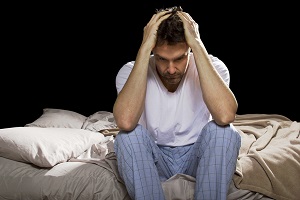
Most, if not all, of us, are familiar with the words “anxiety,” “depression” and “PTSD.”
But not all of us are completely familiar with what each of these disorders actually entails. We may be familiar with the stereotypes of these disorders – such as the assumption that someone battling depression is always sad – but knowledge is otherwise limited.
Because so many people in our world today actually have a diagnosable psychiatric illness, it’s important to understand what exactly that is, what kinds of mental illnesses there are and where to find the right treatment for it, if needed.
What is a psychiatric disorder?
According to the American Psychological Association, a psychiatric disorder (also commonly known as a mental illness), is “any condition characterized by cognitive and emotional disturbances, abnormal behaviors, impaired functioning, or any combination of these. Such disorders cannot be accounted for solely by environmental circumstances and may involve physiological, genetic, chemical, social, and other factors.”
Psychiatric disorders are more common than we may realize, even though recent transparency in social media has led to a greater awareness of the prevalence of mental illnesses. According to The National Alliance on Mental Illness, psychiatric illnesses contribute to the leading cause of disability the world over.
The statistics of mental health disorders are astounding, with about one in five adults—43.8 million people or 18.5 percent—experiencing a mental illness within a given year and about one in five youths ages 13-18 experiencing a severe mental illness at some point. Fifty percent of psychiatric illnesses begin by age 14, and 75 percent are present by age 24.
Common types of psychiatric disorders
As with physical illnesses, some mental illnesses are more common than others. And while it’s important for mental health professionals to be able to diagnose and treat a wide range of disorders, we’re only going to focus on a few of the more common ones below.
Depression
In the year 2020, the number of adults who experienced a major depressive episode reached 21 million people. Depression isn’t just feeling sad or down. Depression is related to specific symptoms that last for more than two weeks. These symptoms may include:
- Lack of energy
- Lack of interest in once-pleasurable activities (anhedonia)
- Feelings of hopelessness and isolation
- Changes in eating habits
- Self-harm
- Thoughts of suicide
Because depression can be so challenging to overcome on one’s own, professional help is often needed to cope with the symptoms of depression.
Attention-deficit/hyperactivity disorder (ADHD)
ADHD is more common in children than adults, with approximately 9 percent of children ages 3-17 reported to struggle with attention-deficit/hyperactivity disorder. ADHD is characterized by inattentive behavior that can include:
- Being easily distracted
- Losing or misplacing everyday items
- Having difficulty focusing
- Having trouble following directions
Signs of hyperactive behavior can include:
- Excessive talkativeness
- Difficulty remaining quiet during activities
- Excessive jitteriness
These combined behaviors must be present for a minimum of 6 months in order to receive a formal diagnosis.
Generalized anxiety disorder
Generalized anxiety disorder (GAD) is characterized by chronic worry as it relates to things and events in everyday life. This can affect many areas related to school, work and one’s social and family life in which a person may avoid daily activities due to an overwhelming sense of fear and stress. A person may become overly exhausted by worrying and may subsequently develop headaches, migraines or stomach aches.
Some symptoms of this anxiety may include:
- Constant nervousness
- Feeling faint or short of breath
- Fatigue
- Insomnia
- Feeling tense or on edge
- Irritability
- Negative thinking or expecting the worst in a situation
A counselor trained in anxiety disorder treatment can help anyone battling anxiety learn how to calm their anxious minds and slowly redirect frantic thoughts.
Post-traumatic stress disorder
Post-traumatic stress disorder (PTSD) can occur when someone experiences a traumatic event in their life, including chronic stress, abuse (physical, emotional, sexual, etc.), the death of a loved one or a violent accident. Not everyone who undergoes a traumatic experience will develop PTSD, as all our brains respond to stimuli differently, but many more people than we realize may battle symptoms. In fact, about 7 or 8 out of one hundred people will develop PTSD in their lifetime.
The symptoms likely to develop include:
- Flashbacks
- Recurring memories or dreams of the event
- Avoiding people, places or things associated with the trauma
- Being easily startled, or seemingly jumpy
- Difficulty sleeping
- Trouble focusing
- Not being able to remember parts of the event
As with most psychiatric disorders, treatment is often needed to help one learn to cope properly with these symptoms.
Treatment for common psychiatric disorders
With most psychiatric illnesses, research has shown that a combination of one’s genes and environment contributes to the onset. In other words, brain chemistry and activity coupled with outside stressors related to one’s family, school and social life play a vital role in whether or not a psychiatric illness is going to develop.
At High Focus Centers, we recognize the importance of treating psychiatric illnesses. Our DBT-focused program can help you or your loved one recognize and implement the needed changes to live a healthy and productive life, free from the symptoms of any mental health condition.
To get in touch with someone today, contact us to learn more.
Recent Posts
- How Mood Stabilizers Work to Restore Emotional Balance
- Trauma-Informed Approaches in Therapy: Why Understanding Trauma is Essential for Healing
- Using Art as a Voice: Exploring the Therapeutic Benefits of Creativity
- What is Xylazine?
- How Overcoming Roadblocks is Crucial to Recovery – And How Your Treatment Center Can Help




